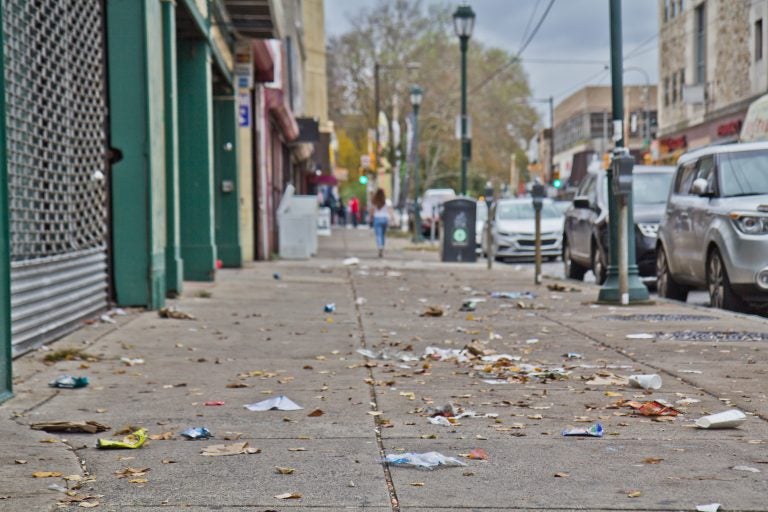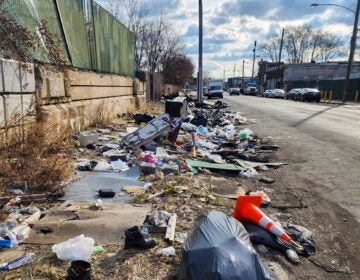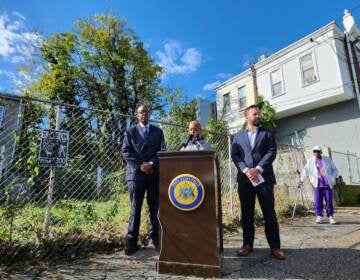Philly names 6 neighborhoods for street cleaning experiment
Philadelphia will launch a new street cleaning effort in six areas now battling extreme amounts of litter. The new brooms will officially roll out Tuesday.

Litter blows on Germantown Avenue. (Kimberly Paynter/WHYY)
This story originally appeared on PlanPhilly.
—
Philadelphia, a city whose name has become nearly synonymous with litter, is launching a first-of-its-kind sanitation pilot effort that will seek to clean up six particularly trash-strewn sections of the city.
Officials first announced they were considering new anti-litter strategies after a WHYY/PlanPhilly investigation revealed the city was rarely sweeping the few streets included in the city’s limited weekly cleaning rotation. The report also found that the Philadelphia Parking Authority was nevertheless still issuing street cleaning-related parking tickets, despite the lack of actual cleaning.
In a response to these findings, Philadelphia Managing Director Brian Abernathy said the city would soon test an experimental method of cleaning streets without the need for ticketing — namely, deploying an army of workers armed with backpack-mounted leaf blowers and hand brooms to dislodge trash from underneath parked cars.
Abernathy said Monday that the pilot will bring the new brooms and blowers to the following areas:
- West Philadelphia: Parkside Ave. to Lancaster Ave., from 52nd St. to Girard Ave.
- Southwest Philadelphia: Woodland Ave. to Kingsessing Ave., from 49th St. to Cemetary Ave.
- Kensington: 2nd St. to Frankford Ave., from Tioga St. to Lehigh Ave.
- Strawberry Mansion: Diamond St. to Lehigh Ave., from 29th St. to 33rd St.
- Logan: Godfrey Ave. to Roosevelt Blvd., from Broad St. to 5th St.
- South Philly: McKean St. to Oregon Ave., from 4th St. to 8th St.
“These are neighborhoods that, by evaluation, are dirty,” Abernathy said of the pilot areas. “They have more litter than the average community. We wanted to start where the need was highest.”
The street cleaning will officially begin on Tuesday and continue through December, after weekly trash collection days. The cleaning will be done once a week.
Abernathy said the areas were selected through a “data-driven process” involving the city’s so-called “litter index.” This index ranks neighborhoods on a scale from one to four — from relatively clean streets to areas that have experienced repeat illegal dumping. Abernathy said all of the neighborhoods selected for cleaning had consistently scored a “two” or worse.
Mayor Jim Kenney announced in March that he would seek to triple the street-sweeping budget to $2.3 million for this project, as well as the purchase of additional “broom trucks” and laborers to boost service across the city.
The city’s Streets Department will officially kick off these efforts on Tuesday, following a “soft launch” that saw crews testing out the leaf blower method around the city over the past few weeks. The enhanced cleaning program will cost $425,000 to run through the remainder of this fiscal year, with future years funded out of Kenney’s proposed bump to the sanitation budget — assuming the mayor’s proposed budget clears a City Council vote.
However, the announcement of the new litter collection strategy has already drawn controversy from residents concerned about noise, efficacy, and other concerns.
“Running a blower for one hour emits as much dangerous contaminants as driving a modern-day Toyota Camry from Philly to Tampa,” said David Brindley, a volunteer with 5th Square, an urbanist political action committee. “I have not seen any indication that the Health Department or Office of Sustainability has weighed in on the effect this will have on air quality.”
Brindley’s group went so far as to produce a staged video showing the blower packs in action, which purports to show that the strategy is flawed. In the recording, muck that has built up in the curb line is messily ejected onto a nearby vehicle by the force of the blower.
“Leaf blowers do little to remove caked-on sludge,” Brindley said.
Abernathy said he had heard these complaints and seen the video. He emphasized that the leaf blower project was part of a flexible and ongoing effort to improve litter collection citywide, and could be revised.
“We think this is an interesting model to try. I don’t think we’re wedded to it. We want to learn as much as we can from it going forward,” he said. “I don’t think any of us are naive enough to say this is going to be a perfect process, but we’re excited that we’re finally tackling some of the trash and litter issues the city has faced.”
Editors Note: A prior version of this article included incorrect boundaries for Kensington’s cleaning area due to an error in information provided by the city.
WHYY is your source for fact-based, in-depth journalism and information. As a nonprofit organization, we rely on financial support from readers like you. Please give today.







